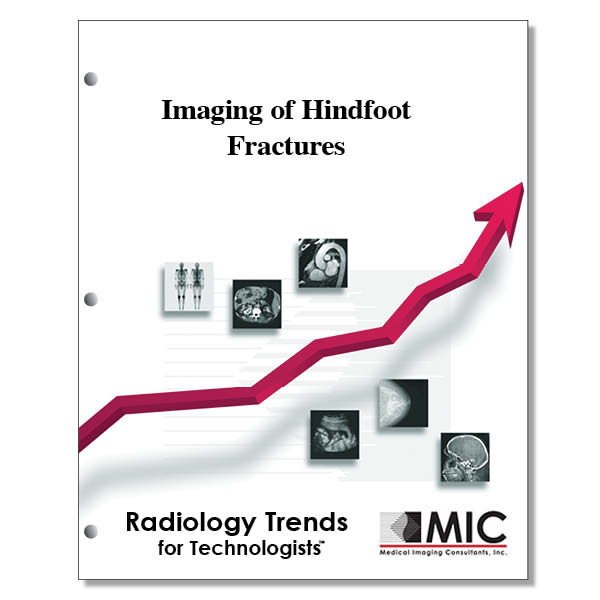

Imaging of Hindfoot Fractures
A review of anatomy and pathology intended to aid in surgical management and restoration of articular and hindfoot alignment for optimal ankle and foot function.
Course ID: Q00710 Category: Radiology Trends for Technologists Modalities: CT, Radiography2.75 |
Satisfaction Guarantee |
$29.00
- Targeted CE
- Outline
- Objectives
Targeted CE per ARRT’s Discipline, Category, and Subcategory classification:
[Note: Discipline-specific Targeted CE credits may be less than the total Category A credits approved for this course.]
Computed Tomography: 2.75
Procedures: 2.75
Head, Spine, and Musculoskeletal: 2.75
Magnetic Resonance Imaging: 0.25
Procedures: 0.25
Musculoskeletal: 0.25
Nuclear Medicine Technology: 0.25
Procedures: 0.25
Other Imaging Procedures: 0.25
Radiography: 2.75
Procedures: 2.75
Extremity Procedures: 2.75
Registered Radiologist Assistant: 2.75
Procedures: 2.75
Musculoskeletal and Endocrine Sections: 2.75
Sonography: 0.25
Procedures: 0.25
Superficial Structures and Other Sonographic Procedures: 0.25
Outline
- Introduction
- Talus
- Anatomy
- Epidemiologic Features
- Imaging
- Classification
- Talar Body
- Compression or Osteochondral Dome Trochlear Fractures
- Shear Trochlear Fractures
- Crush Comminuted Trochlear Fractures
- Posterior Process Fractures
- Lateral Process Fractures
- Talar Neck
- Talar Head
- Subtalar and Total Talar Dislocations
- Calcaneus
- Anatomy
- Epidemiologic Features
- Imaging
- Pathologic-Anatomic Features
- Imaging Assessment and Classifications
- Radiological Assessment with Essex-Lopresti Classification
- Tongue Type
- Joint Depression Type
- CT Assessment with Sanders Classification
- Management
- Conclusion
Objectives
Upon completion of this course, students will:
- be familiar with the frequency of fractures in the hindfootknow the anatomy of the ankle and foot
- be familiar with the arteries supplying the talusrecognize the frequency of fractures in the talus
- be familiar with the ipsilateral extremity injuries accompanying talar fractures
- understand the use of CT for diagnosing talar fracturesknow the classification of talar fractures
- be familiar with the Inokuchi et al definition of talar neck fractures
- recognize the common type of talar body fractures
- be familiar with the dome compression fractures of the talar body
- be familiar with the classification systems for staging osteochondral defects of the talus
- recognize the patterns for isolated shear fractures
- be familiar with shear fractures of the talus
- understand the risk of avascular necrosis in crush comminuted trochlear fractures of the talar body
- be familiar with Shepherd fractures of the talusrecognize “snowboarder” fractures of the talus
- be familiar with the differing type and complications of talar body fractures
- know the mechanism of injury associate with lateral process fractures of the talar body
- be familiar with the classification system use for lateral process fractures of the talus
- understand the use of CT for diagnosing lateral process fracturesknow the causes of modern talar fractures
- be familiar with the classification of talar neck fractures
- be familiar with the Hawkins-Canales typing of fractures
- be familiar with the frequency of avascular necrosis using the Hawkins sign
- identify the imaging modalities that can be used to help determine viable blood supply in patients with talar neck fractures
- identify the distinct fracture patterns found in the talar head
- be familiar with talar neck fractures associated with subtalar dislocationknow the mechanism of injury for talar neck fractures
- be familiar with type III Hawkins-Canales talar neck fractures
- be familiar with the anatomy of the hindfoot
- be familiar with the surfaces of the calcaneus
- be familiar with the articular facets of the calcaneusidentify the largest calcaneal articular facet
- recognize the Achilles tendon insertion site on the calcaneus
- be familiar with the thalamic portion of the calcaneus
- recognize the calcaneus as the most frequently fractured tarsal bone
- recognize the use of the lateral view for measuring Bohler and Gissane angles
- understand the patient outcome resulting from a wide, short, and depressed calcaneus
- be familiar with the Essex-Lopresti classification system
- recognize the advantages of CT for calcaneal fractures
- be familiar with the Sanders classification system for the posterior joint surface of the calcaneus
- recognize the prevalence of compartment syndrome for patients with calcaneal fractures
- be familiar with the orthopedic goal for managing patients with calcaneal fractures
